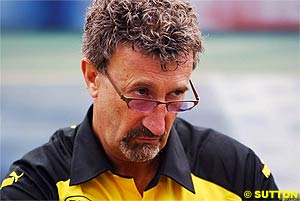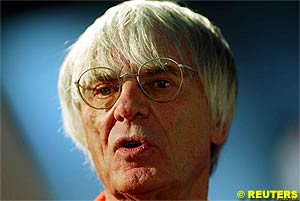Atlas F1 Magazine Writer
Fresh from the Formula One paddock
It used to be so easy: when Bernie Ecclestone, in 1958, wished to compete in the Monaco Grand Prix, he simply bought a used Connaught, and entered. At the same time Colin Chapman took Lotus from success on a shoestring in lesser formulae to Formula One by simply building better cars than the opposition.
Formula 2/3 entrant Ken Tyrrell decided to join the 1968 F1 fray, so he accepted a chassis from Matra, bummed a budget from Ford and Dunlop, and signed one John Young Stewart. A year later they bagged both World Championship crowns... Then Tyrrell bought a March - with which Stewart won the 1970 Spanish Grand Prix, being the last private entry to do so - before becoming constructor in his own right. Would that have been possible without 'off-the-shelf' chassis?
When Lord Hesketh elected to enter Formula One as a 'patron' in 1973, he rented a March from Mosley and entered James Hunt as driver. After good performances a car was acquired; better performances led the good Lord to order the construction of an eponymous chassis. Soon maiden victory rolled in.
So it has gone over the years: Frank Williams was a successful F3 entrant before gradually moving his company upmarket. Ron Dennis, too, migrated from F2 to F1, as did Giancarlo Minardi; Eddie Jordan went from F3 success to Grand Prix wins after excellence in F3000. Tom Walkinshaw, Guy Ligier and Peter Sauber used sportscar successes as springboards, ultimately joining the GP club. Jackie Stewart, with son Paul, established a 'staircase of talent': youngsters could join his outfit in junior formulae, then step up to Formula Lotus Opel and reach F1 via in-house F3 and F3000 teams.
In the late eighties a typical Grand Prix programme listed 38 - yes, 38! - cars. Twelve were required to pre-qualify, with the top four joining 26 others who had achieved eligibility on the grounds of previous (recent) performances. Of those 30, the 26 quickest started on Sunday afternoon; the balance bagged early showers and were home before the race even started – with Friday's stragglers departing before first practices even started!
It was survival of the fastest, and a natural elimination process worthy of the pinnacle of the sport; worthy, above all, of the term 'World Championship'. Without exception all successful entrants were lean, mean, imaginative; born racers who relished beating every challenge the sport could and did chuck at them. Some swam, some floated and the incapables sank, but all did so in the knowledge that they had taken on all-comers in the world's most unforgiving sport.
Then, in early 1999, something rather strange happened: the F1 Commission, supported by the FIA, decided that Formula One should be a closed club, open only to 12 teams (24 cars), and any newcomers would be required to post a bond of $48m merely to signal intention of entry. Yes, more than Minardi's entire operating budget for 2004 - as per BusinessF1's latest numbers - would be tied up in a bond to prove 'seriousness' as it was described then; an amount equalling 2/3rds of Jordan's 2004 budget – as per the same source - tied up in a bond.
Put differently, at a time when no less than $100m is required to set up a very basic F1 team – without wind tunnel or motorhomes – no less than half of that then need be raised again to convince the FIA of fledgling teams' 'seriousness'! Sure, the interest-earning bond would be refundable in 12 equal instalments should the team survive, but consider the critical capital tied up just when a fledgling operation requires every damn cent it can lay its hand on to.
Any wonder, then, that no entrepreneurs have 'seriously' enquired about entering F1 in the last six years? That Toyota, which funds its entire programme out of interest earned on its world-wide cash deposits, has been the only new entrant in all that time? Time was when a six year period would have seen at least 12 teams make their entries into the sport.
According to Jackie Stewart, "there was a time and place for it," and, certainly, there was rationale in it: the likes of Andrea Moda, Life, Simtek and Pacific had arrived in F1 on weak wings and strong prayers and departed in utter shambles and shame. The bond would, it was suggested, ensure total 'seriousness' accompanied entry attempts through the risk of forfeiture in the event of failure. Well, what chance of survival if wholly one-third of your working capital is untouchable?
The net effect of this? Minardi teetering on the brink by end-2000 (despite Giancarlo Minardi, in 1999, describing the 12-team covenant as 'a sponsor without a sticker...'), saved from extinction only by the optimistic enthusiasm (and facilities) of Paul Stoddart; Prost dead and buried; Arrows gone in puffs of recriminations and legal battles. Jordan - the team owner, not the man - pleads poverty at every turn, and, of the entrepreneurs, only Peter Sauber has reason to be a touch sanguine (although he is, accuse detractors, using a copy-cat - copy-horse? - car).
But, now it seems there will be a rethink on this 12-team/bond policies – and not a moment too soon. Max Mosley has called a meeting of team principals (scheduled for 5 May in Monaco), and topping the agenda, we hear, is the question of expanded grids and entry affordability.
Of course, should a change come to pass, something will have to give – his current crusade to introduce speed reductions, perhaps? – but, unless F1, in these Red Wash days and resultant TV switch-offs, wishes grids to drop below the 20 (or, conceivably, 16) mark, rising speeds are a small price to pay for bolstered fields. So much for 'sponsors without stickers'…
So, what can be expected should the bond and car-limit be abolished? Not a lot, frankly, unless further assistance or 'retribution' is granted to hopefuls, for, since 1999, F1 has moved along at an unrelenting pace, and, as proven by Toyota at present, money alone does not ensure success – it merely opens doors. So, removal of the bond should be coupled with concessions - such as enabling newcomers to purchase intellectual properties and major components from existing constructors whilst building up their own technological bases and expertise.
So, the Super Nova F3000 operation – which already enjoys close links with Jordan - could, for example, purchase the intellectual property rights to the EJ14's basic chassis and aerodynamics. Recovering revenue from the previous (or current) year's developments would aid the yellow team's quest for balanced books, whilst enabling David Sears' multiple championship-winning outfit to step up to the premier formula.
There are others which, too, could prepare for promotion: reigning F3000 champions Arden; Carlin, which manages respected F3 and F Nissan entries; Coloni, which stepped back to F3000, and never found the funds to post the bond; even the nascent teams of former champions Keke Rosberg and Nelson Piquet. There are still others in operating in various formulae, of course, and if only three take up the challenge by 2006, 26-car grids will be back. And, two more by 2008...
Some – newcomers and old - will fold and others replace them, for sure, but such is the nature of the Championship. They have dropped in and out in the past - since the inception of the championship in 1950 no less than 126 teams have lodged entries progress; of those, 10 remain today. But, where in the past, replacements were waiting to step into their Pumas, since 1999, no newcomers have even vaguely hinted their intentions. Where, in the past, teams have joined at the average rate of 2.3 per year, since 1999 only Toyota has joined the fray. All other 'arrivals' have been no more than take-overs or buy-outs, call it what you like, of existing teams!
On 5 May, Formula One has the opportunity of voting for expanded grids. There will be dissention in the ranks - some, rather selfish, individuals are said to be 'protecting' their investments by keeping the entry price artificially high – but good, common business sense should prevail in the end: after all, what is a team really worth without competition? It is that easy.
Just why is there this euphoric belief in certain circles that Bernie Ecclestone has 'saved' the British Grand Prix? That the oldest race in the F1 World Championship, at the circuit which hosted the first World Championship Grand Prix, is safe?
Fact 2: Interpublic has never owned the Northamptonshire circuit, which has always been the property of the British Racing Drivers' Club – the membership book of which, incidentally, lists Bernard Charles Ecclestone as having been made an Honorary Member of the institution in 1989 - and the release of Interpublic from future obligations (after this year, and by way of a $93 million payment to Ecclestone) does not guarantee that any future Grand Prix on British soil will take place at Silverstone. In fact, there are no guarantees that a British Grand Prix will take place on any soil, anywhere.
Fact 3: Interpublic did own those circuits it acquired when it purchased Brand Hatch Leisure, but these have been sold to Dr Jonathan Palmer and his associates. Not one of those – from Brands Hatch to Oulton Park – was suitable for a Grand Prix, hence the deal with the BRDC to lease Silverstone. Interpublic is settling that liability to the club separately by spreading approximately $60 million over the next four years.
Fact 4: not three weeks ago, in Bahrain, Formula One's Commercial Rights Holder took another broadside swipe at the Northamptonshire circuit, severely criticising its facilities.
Fact 5: Ecclestone and FIA President Max Mosley have long warned that Formula One will gradually desert its European heartland for territories new: those that are either extremely tobacco-friendly or willing to pay top dollar for hosting privileges – or, preferably both.
Fact 6: Silverstone needs millions – some estimates put it at $50 million - spent on it to bring it up to scratch, with 'scratch' being the operative word.
Fact 7: At any one time Ecclestone has up to 25 Grand Prix applications on his desk. Egypt, Dubai, Kuwait and Mexico are all known to be begging for events, whilst Austria is seeking a return.
So, taking due cognisance of the above, it is clear that now, more than ever before, Silverstone's future as a Grand Prix venue, and indeed Britain's future as a host country, is far from guaranteed. In what chance Britain – with its long-term contract cancelled - when the Concorde agreement allows only 17 races – with premium clauses for additions?
Then it has been suggested that Ecclestone will invest his $93 million 'windfall' in Silverstone. Just why on earth should he do so in a circuit situated in a tobacco-hostile country which is a signatory to the European Arrest Warrant, when free-market countries are falling over themselves to host Grands Prix without any need for outside investments? So, will the BRDC invest this money? Has it in the recent past? Does it even have the money to invest in what is increasingly becoming a risky commercial venture?
None of the above ties in with Ecclestone's (and Mosley's) vision for state support for Grands Prix. If anything, unless the British government signals such intention very soon, Ecclestone has every reason to can the race.

 In 1969, having realised that he would not find top-line success as a driver, present FIA President Max Mosley set his sights on establishing an F1 operation. Along with four mates and $4,000, he founded March late that year. By early 1970 five cars lined up for the South African Grand Prix. By season's end, March was Formula One's largest constructor, with works and privateer entries campaigning (at times, winning with) 701s in Grands Prix held on African, European, and Central and North American soils.
In 1969, having realised that he would not find top-line success as a driver, present FIA President Max Mosley set his sights on establishing an F1 operation. Along with four mates and $4,000, he founded March late that year. By early 1970 five cars lined up for the South African Grand Prix. By season's end, March was Formula One's largest constructor, with works and privateer entries campaigning (at times, winning with) 701s in Grands Prix held on African, European, and Central and North American soils.

 Fact 1: Interpublic's release from its BGP commitments (which, in turn of the original contract ran until 2015) come into effect next year; for this year the marketing company, which lost millions in any currency through its non-diligent dabbles in motorsport, is still responsible for promoting the Grand Prix at Silverstone.
Fact 1: Interpublic's release from its BGP commitments (which, in turn of the original contract ran until 2015) come into effect next year; for this year the marketing company, which lost millions in any currency through its non-diligent dabbles in motorsport, is still responsible for promoting the Grand Prix at Silverstone.
|
Contact the Author Contact the Editor |
Please Contact Us for permission to republish this or any other material from Atlas F1.
|
Volume 10, Issue 16
Atlas F1 Exclusive
Interview with Bob Bell
Interview with Gianmaria Bruni
Articles
Every Other Sunday
The Paint Job: Part V
2004 San Marino GP Preview
2004 San Marino GP Preview
San Marino GP Facts & Stats
Columns
The F1 Trivia Quiz
Rear View Mirror
Bookworm Critique
On the Road
Elsewhere in Racing
The Weekly Grapevine
> Homepage |
